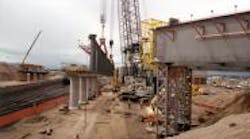“The TIGER team will identify and prioritize key highway, bridge, transit, rail, aviation and intermodal spending. The team also will develop reporting standards to accurately track the money as it is being spent and ensure that all accountability requirements are being met.” –Ray LaHood, newly confirmed U.S. Secretary of transportation, on how his agency plans to handle its portion of the nearly $1 trillion stimulus bill being crafted by Congress
One of the first moves by Transportation Secretary Ray LaHood is the creation of a TIGER team to coordinate what is shaping up to be a massive infusion of cash into the depleted Highway Trust Fund from the nearly $1 trillion stimulus bill still being finalized by Congress.
“TIGER” stands for “Transportation Investment Generating Economic Recovery” and this team is going to be composed of officials from across the DOT’s operating administrations and offices, ostensibly to make sure that DOT’s portion of recovery funding goes out to states and localities as quickly as possible in order to immediately create jobs and strengthen our economy and transportation system, the agency says.
[You can read more about this at the Transportation Secretary’s blog on the DOT’s website.]
Yet none of this addresses the real problem when it comes to maintaining our bridges, highways, and roads – chronic underfunding. According to the National Surface Transportation Policy and Revenue Study completed last year, when Congress authorized SAFETEA-LU at $286.5 billion in 2005, it was expected that revenues flowing into the Highway Trust Fund would be sufficient to support the program through its sixth and final year. While it was expected that outlays would exceed revenues over the course of the bill by approximately $5 billion, it was estimated that the program would remain solvent long enough for other measures to generate the revenues necessary to sustain the program at the levels authorized in SAFETEA-LU.
However, it appears that the “tipping point” is expected to be reached in fiscal year 2009, according to the study – as in right now. Based on the information provided in the Treasury Departments’ Midsession budget Review forecast for FY 2008, the highway program faces a serious funding crisis beginning in fiscal year 2009, showing a shortfall of $4.3 billion in revenue. That shortfall requires an obligatory reduction of around $16 billion in funding, since it takes just under $4 to save $1 in spending, the study concluded.
What to do, what to do? Well, the commission in charge of that massive study came up a more than 100-page solution I’ll boil down for you into three words – raise fuel taxes.
According to the study, due to the rising costs of construction, the value of the 18.3 cents Federal gas tax rate will decline 55% or to 8.3 cents between 1998 and the end of 2015 if “corrective action” is not taken. That “corrective action” in the commission’s view means raising the federal fuel tax by 10 cents a gallon between 2009 and 2015 – 3 cents or its equivalent in 2009 to sustain the program at the level guaranteed in SAFETEA-LU, and another 7 cents or its equivalent in 2010 to restore the program’s purchasing power.
That’s just the start, of course, for you have the STATES to consider – and they are shoulder-to-shoulder with the feds on fuel tax increases. California, Massachusetts, New Hampshire, Illinois and Oregon, for example, are all introducing bills that would raise gasoline taxes for road and bridge repair. Every state except Alaska has fuel taxes, but most haven’t been raised for more than a decade and they often are not indexed to inflation.
How much are we talking here? Ohio’s fuel tax task force recommends a 13 cent per gallon increase, Illinois is contemplating 8 cents per gallon, and New Hampshire is seeking a 15 cent per gallon boost over the next three years. Considering that the average state tax on gasoline alone is 30 cents per gallon (with California the highest at 48.7 cents per gallon) we’re talking about a lot of money here.
Here’s the thing though – most of the truckers I talk to would NOT mind a fuel tax increase, first because it’s better than raising highway tolls (or worse ADDING highway toll booths) or selling off public roads to private entities, but also because truckers realize the roads are in bad shape.
HOWEVER – and this is a critical point made in every conversation I have – truckers want MORE ACCOUNTABILITY for how that fuel tax money gets spent. Almost half the states, for example, put fuel tax revenues into their general funds, meaning it gets spent on everything under the sun and not necessarily the roads. A good 20% of the revenues collected by the federal fuel tax gets spent on mass transit projects – a worthy goal, but that doesn’t help maintain the roads, now does it?
Truckers are tired of watching the fuel tax money they shell out at every fuel stop going to parks, bike paths, and other sundries that are not vital to the nation’s transportation infrastructure. If you ask me, it’s these kinds of discrepancies that the DOT’s “TIGER” team should get tapped to look into as well.






